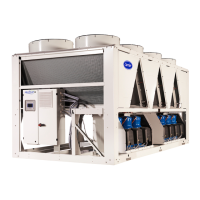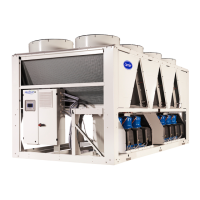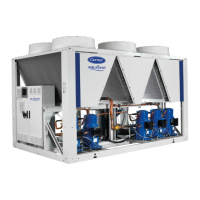52
12.2.4.3 - Installation
The hydraulic supply for each desuperheater is delivered in
parallel.
The hydraulic connection on the desuperheater water inlet and
outlets must not generate any local mechanical stress on the
exchangers. If necessary, install exible couplings.
Fit water ow rate balancing and control valves at the exchanger
outlet.
Balancing and control of the ow rates may be performed by
reading the pressure drop in the exchangers.
The pressure drop on each of these must be identical to the total
water ow rate given by the selection programme.
To adjust the balancing valves before starting up the system, refer
to the pressure drop curves below.
It is possible to ne-tune the water ow rate settings for each
desuperheater when the unit is running at full load by trying to
obtain leaving water temperatures which are strictly identical for
each of the circuits.
1 Circuit with 1 compressor
2 Circuit with 2 compressors
3 Circuit with 3 compressors
4 Circuit with 4 compressors
Heat exchanger pressure drop, kPa
1
10
Heat exchanger water ow rate, l/s
1
2
3
4
12.2.4.3 - Operation
The desuperheater water circuit pump (see standard diagram
– item 20, in the section on "Installation and operation of the
heat recovery with desuperheater option") can be operated
in conjunction with:
• Start-up of the rst unit compressor: terminal 37/38
• Heating water requirement: output DO-01, terminal
491/492, on the EMM board.
A dedicated ow switch (item 29) can also be installed to
generate an alarm if there is a problem with the pump
(customer control system).
The volume of the desuperheater circuit water loop must be
as low as possible to be able to rapidly increase the temperature
during warm-up.
The minimum desuperheater entering water temperature is
25°C.
This may require the use of a three-way valve (item 31), with
its controller and sensor controlling the minimum required
entering water temperature.
It is essential for the desuperheater water loop to comprise a
valve and an expansion vessel which must be selected to take
the volume of the water loop and the maximum possible
temperature into account
(120°C), in the event that pump (item 20) stops running.
12.2.4.4 - Operating limits
Entering water temperature at start-up °C 25
(1)
75
Leaving water temperature during operation °C 30 80
Air condenser
Outside operating temperature °C 0
(2)
46
(1) The entering water temperature at start-up must not be lower than 25°C.
For installations with a lower temperature a three-way valve is necessary.
(2) The minimum outside temperature is 0°C; -20°C with the winter operation option.
12.2.4.5 - Control conguration with the desuperheater option
This conguration enables the user to enter a setpoint relating
to the minimum condensation temperature (default value =
30°C) to increase the heating capacity recovered for the
desuperheaters, if required.
In fact, the recovered heating capacity percentage in relation
to the total capacity released by the air-cooled exchanger
increase based on the saturated condensation temperature.
Refer to the control manual for adjustment of the minimum
saturated condensation temperature setpoint.
Other parameters directly affect the effective capacity
recovered from the desuperheater, which are mainly:
• The unit's load rate, which governs whether it runs at full
load (100%) or at part load (depending on the number
of compressors the unit has per circuit).
• The entering water temperature in the desuperheater,
depending on the unit's "Heating" or "Cooling" operating
modes:
- in "Heating" mode, the entering water temperature in
the water type heat exchanger
- in "Cooling" mode, the ambient temperature at the air-
cooled exchanger air inlet.
12.2.5 -
Operation of 2 Master/Slave units (Option 58)
The customer must connect both units with a communication
bus using a 0.75 mm² twisted, shielded cable (contact the
manufacturer's Service for installation).
All parameters required for Master/Slave operation must be
congured by the Service conguration menu.
All remote controls of the Master/slave assembly (start/stop,
setpoint, load shedding, etc.) are managed by the unit
congured as the Master and must only be applied to the
Master unit.

